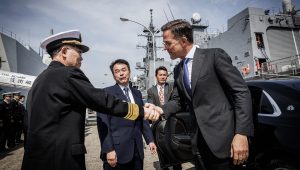When NATO Secretary General Mark Rutte touched down in Tokyo on his first visit to the Indo-Pacific as the new chief, it underscored a paradigm shift in the global security landscape: Japan is rapidly repositioning itself as Europe’s most important security partner in Asia.
This realignment, driven by growing doubts among Japanese and European policymakers about the reliability of the United States, marks a turning point. Moving forward, Japan and Europe must chart a more independent course and build a security partnership on their own terms.
Under a belligerent Donald Trump, Washington is veering toward an increasingly isolationist foreign policy. Just months into his second term, Trump has launched a protectionist trade war, publicly chastised NATO allies, and taken swipes at Japan over the U.S.-Japan security treaty, remarking, “We have an interesting deal with Japan that we have to protect them, but they don’t have to protect us.”
Despite Trump’s lambasting, Japan is increasingly transforming into a proactive security actor. Under its revised National Security Strategy, implemented by former Prime Minister Kishida Fumio, the country is doubling its defense budget and acquiring counterstrike capabilities. It is also deepening its security ties in Southeast Asia by positioning itself as a bridge between traditional regional institutions like ASEAN and newer strategic groupings such as the Quad.
Japan recently expanded its long-standing development programs to include political and security cooperation, introducing an Official Security Assistance framework that supports military capacity-building in partner countries, aiming to offer an alternative to China’s development model. Through these efforts, Tokyo seeks not only to reinforce the rules-based international order but also to strengthen its influence among Global South nations and maintain ASEAN centrality in the evolving Indo-Pacific architecture.
These once-unthinkable steps signal a growing realization in Tokyo: relying too heavily on the United States is no longer a sustainable path forward. Japan needs more allies.
This is where Europe enters the picture. Since former Prime Minister Abe Shinzo’s visit to NATO headquarters in 2007, Japan has steadily deepened its ties with the alliance, culminating in the recent opening of a dedicated NATO office in Brussels. Just last week, Foreign Minister Iwaya Takeshi met with Rutte in preparation for his arrival in Japan.
Rutte’s visit and meeting with Prime Minister Ishiba Shigeru was, therefore, not merely a handshake or a photo-op. It was a signal of strategic intent from both sides. Ahead of his visit, NATO’s top official stressed the need for concrete progress in Japan-NATO ties,, stating, “We need to have more flesh on the bones.” He underscored the importance of moving beyond joint declarations toward practical cooperation, particularly in defense production and intelligence sharing on shared security concerns. “Let’s make it practical,” Rutte urged.
NATO increasingly sees Japan, alongside South Korea, Australia, and New Zealand (the Indo-Pacific Four, or IP4), as essential allies. East Asia is facing rising tensions from a more assertive China and a nuclear-ambitious North Korea, both of which often coordinate with Moscow and Tehran. The security of the Euro-Atlantic and Indo-Pacific, as Japan’s former Foreign Minister Kamikawa Yoko stated during a visit to Europe, is “inseparable.” The rise in joint China-Russia naval drills near Japanese waters and reports of North Korean troops operating in Ukraine starkly illustrate how threats easily spill over into multiple regions.
Despite this, Europe’s strategic focus remains narrow. During recent visits, U.S. Secretary of State Marco Rubio and Secretary of Defense Pete Hegseth delivered unsettling messages to Europe. Rubio demanded NATO countries raise defense spending to 5 percent of GDP, while Hegseth’s unilateral dismissal of Ukraine’s NATO membership and Trump’s outreach to Putin, without consulting European allies, deepened fears of U.S. disengagement. This has led some European policymakers to quietly contemplate a NATO future without the United States.
As a result, critics of NATO’s engagement in the Indo-Pacific argue that the alliance lacks the capacity or mandate to expand its role beyond Europe. They warn of overreach and distraction from these more immediate concerns. But this critique misunderstands both NATO’s evolving posture and Japan’s intentions. Tokyo isn’t asking for European boots on the ground in, for example, a potential Taiwan crisis. Instead, Japan seeks practical cooperation: cyber defense, space security, strategic communication, and defense-industrial collaboration. This form of engagement doesn’t drain NATO’s resources. It complements them.
Importantly, Japan’s outreach is not directed solely at NATO as an institution, but at European nations that are NATO members. Tokyo has significantly expanded defense cooperation with countries like the United Kingdom, Germany, Italy, and France through reciprocal access agreements, joint fighter jet development, and an increasing number of joint military exercises. These bilateral ties form the backbone of Japan’s Indo-Pacific strategy, where it sees European engagement as both welcome and necessary.
In an era of nuclear brinkmanship, cyber warfare, and global power realignments, NATO and its European members cannot afford to view the Indo-Pacific as a distant concern. Japan’s expanding cooperation with Europe is not a distraction but a strategic necessity. It is a chance to help shape the future of global security before others do, while reflecting a clear understanding that security today is shared across regions. Defending peace requires more allies, not fewer – especially as the United States, under the Trump administration, becomes an increasingly uncertain and unreliable one.

































